Tixel at Belgravia Dermatology
- Why – Treatment with Tixel provides excellent results at refreshing and tightening the skin and eyelids, improving acne scars and restoring the glow.
- Areas – Face, eyelids, neck, décolletage, back of hands
- Frequency – Tixel Intense or Tixel Super Intense 1 to 3 treatments spaced every 6-8 weeks. Tixel Glow 3 to 6 treatments spaced every 4 weeks.
- Results – visible in one week and lasts for years
- Downtime – 1 to 7 days (you decide)
Tixel – our results
Tixel videos
What is Tixel?
Tixel is a totally new way of treating the skin using thermo-mechanical ablative (TMA) technology. It was first introduced in the UK in 2017 by Dr Harryono Judodihardjo at Belgravia Dermatology.
Tixel works by the direct use of heat to produce effects of anti-ageing and scar improvement.
Unlike other therapies which are currently available, Tixel is not laser, ultrasound or radiofrequency. Tixel treatment is truly tailored to your needs based on your skin concerns and how much down time you are able to have.
Why choose Belgravia Dermatology in London for Tixel?
Belgravia Dermatology is the leading centre for Tixel in the UK. Since 2017, all UK Tixel clinics have been trained at Belgravia Dermatology. We have also carried FDA approval studies on Tixel, and written internationally used protocols for delivering safe and effective treatment. Based on the extensive experience of our doctors we are able to provide truly individualised Tixel treatment to meet the concerns of a particular patient. We also understand the way skin interacts with Tixel, so we can deliver safe treatment with results.
 How Tixel improves the skin:
How Tixel improves the skin:
Skin tightening
Tixel tightens the skin (dermis) and improves lines, wrinkles, sagging and dilated pores as well as acne scars.
Skin resurfacing
Tixel regenerates the skin (epidermis) and produces an even the skin tone, reduces pigmentation and other blemishes to produce a glow. Active acne responds very well to Tixel as well.
Drug delivery
Tixel is used to create tiny pores in the skin to allow the penetration of medications through the skin. Medications may include those that reduce pigmentation, increase collagen production and relax muscles.
How does Tixel work?
The skin is gently heated using a grid of tiny pyramids the size of pinheads. 81 of these make contact with the skin for only a few thousandths of a second with each shot of treatment.
This allows heat to be transferred to the skin in a controlled manner causing the skin to tighten and rejuvenate. As the contact made with the skin is so short-lived, the level of discomfort is significantly lower than it is for other resurfacing and tightening treatments.
The tiny little microcrusts can be seen in a grid pattern as shown in the picture below. When compared to fractional CO2 laser, there is much less charring and redness which means that make-up or a tinted moisturiser can be applied earlier on.
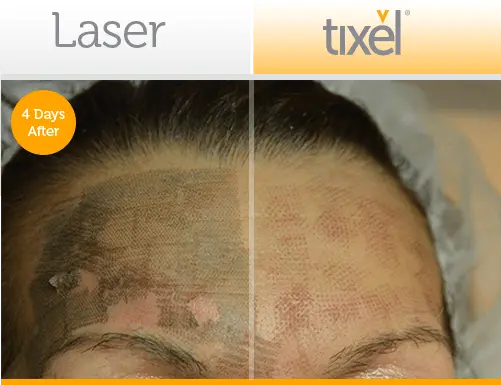
Ablative vs. non-ablative Tixel
Both ablative and non-ablative treatments can be given.
Tixel Glow is a non-ablative Tixel treatment and is less intense. It has a very fast recovery. As non-ablative treatments are gentler, they are suitable for those with less available time for recovery. More treatments are required to get similar effects to ablative treatment.
Tixel Intense and Tixel Super Intense are ablative Tixel treatments and penetrate more deeply in the skin, and have a greater number of passes. This means more of the surface area of the skin is treated. These forms of treatment are more intense and the recovery period slightly longer.
Tixel Glow, Tixel Intense, Tixel Super Intense
Tixel glow
What is Tixel Glow?
Tixel Glow is a non-ablative treatment which is perfect for those who can not afford any down time. Tixel glow is used for general freshening up, keeping on top of mild pigmentation, sun damage and fine lines, and restoring the glow. Tixel glow also keeps the skin smooth and brighter.
What is the Downtime for Tixel Glow?
The down time is very little. Make up can be applied straight away. Our patients may go back to work or to a social event straight away or within a few hours. There will be some mild redness straight after treatment which clears within a few hours. Swelling is also minimal.
How many treatments are required?
Your doctor may recommend between 3 to 6 treatments. Treatments are every 4 weeks. Results can be maintained with a twice a year maintenance treatment.
Tixel Intense
What is Tixel Intense?
Tixel Intense is an ablative treatment in which higher energy setting are used. Tixel Intense is used for medium depth lines and wrinkles, more pronounced sun damage and pigmentation, acne scars, localised epidermal lesions (sun spots, flat seborrhoeic keratoses).
What is the Downtime for Tixel Intense?
The down time is between 2 to 4 days. Make up can be applied after 2 or 3 days. There will be redness for a week or for up to 6 weeks (this is usually mild and can be covered with a tinted moisturiser) and swelling that takes 1 to 3 days to clear.

Your doctor may recommend between 1 to 3 treatments. Treatments are every 6 weeks. Results can be maintained with once or twice a year maintenance treatment.
Tixel Super Intense
What is Tixel Super Intense?
Tixel Super Intense is an ablative treatment in which higher energy setting are used, and more passes are given. Passes are the number of times Tixel is passed over the skin. Tixel Super Intense is used for very deep lines and severe photodamage, as well as for more severe acne scars.
What is the Downtime for Tixel Super Intense?
Make up can be applied after 4 or 5 days. There will be redness for up to 4 months, and swelling that takes 2 to 5 days to clear.
How many treatments are required?
Your doctor may recommend between 1 to 3 treatments. Treatments are every 8 weeks. Results can be maintained with a once or twice a year Tixel maintenance treatment.
Which areas can be treated with Tixel?
Tixel treatment can be to any areas in which there are concerns.
The most commonly treated sites are:
- Face
- Eyelids
- Neck
All three zones can be treated together, or any one area can be treated according to your individual needs.
Here is an example of someone who has had Tixel Intense treatment to the face, eyelids and neck:

- Décolleté (the upper chest)
- Backs of the hands
Tixel for darker skin
We are able to safely treat skin types 1 to 5 with Tixel. These are from fair individuals to Indian and asian complexions. Energy settings are reduced for darker skin types, and therefore more treatments may be required. There is a greater chance of post inflammatory hyperpigmentation in darker skin types. However, meticulous avoidance of the sun reduces the chances of post inflammatory hyperpigmentation significantly. Where it occurs, we have found that it settles within 90 days of treatment.
 Can men be treated with Tixel?
Can men be treated with Tixel?
Yes! Tixel is a very effective treatment for men. About 25% of our Tixel patients are male. Common concerns in men include the signs of ageing and acne scars.
How often are Tixel treatments required?
Your Dermatologist will discuss the number of treatments your skin requires with you at your consultation. This will depend on your goals and the type of Tixel treatment you choose to have. With Tixel Glow, usually three to five treatments are required. Treatments are usually 4 weeks apart. With Tixel Intense and Super Intense one to three treatments are required, with intervals of 6 to 8 weeks.
What happens during a treatment?
Treatment takes between 30 to 90 minutes depending on the size of the area which is treated.
Please arrive to your appointment without wearing any make-up. The skin will be thoroughly cleaned. An anaesthetic cream may be applied to the face for twenty minutes. This minimises any discomfort. Once the skin is adequately numbed, treatment can take place.
Several shots, each lasting a fraction of a second, are placed in a row so as to cover evenly the whole area being treated. A tiny sting, if anything, may be felt with each shot.
Certain areas will receive two or more passes of Tixel.
How will I look after treatment?
Much depends on the grade of treatment that is required. There is some redness immediately and a feeling of warmth or a mild sunburn. This continues for half an hour for a light treatment or for up to 24 hours following a stronger treatment
As the redness subsides, the tiny grid marks (known as microcrusts) of the fractional treatment are see. They are typically a brown colour, and may peel or flake. These are present for 3 to 5 days.
Grid marks and microcrusts may not always be present, and will depend on the type of treatment you have had. Some protocols, including heavier treatments, mean that grid marks and microcrusts are very short lived or absent. Sometimes microcrusts are only seen in in certain areas of the face.
What is the aftercare?
Looking after your skin following a treatment is very simple. A moisturiser should be applied every three to four hours for the first couple of days and then twice a day until all the microcrusts have healed. Make up can be applied on the same day for a light treatment or two or three days later after a more intensive treatment. It is important not to pick at the microcrusts – these should be allowed to separate by themselves.
What is the downtime?
One of the main attractions for Tixel treatment is that it has far less downtime than other resurfacing technologies and this can be tailored to you. The amount of downtime incurred depends on the strength of treatment. With Tixel Glow it is it is possible to apply make up straight away or within a couple of hours and return to work. If a more intensive treatment is required then the face may be red for a couple of days, and grids of tiny microcrusts may form. See above for more detailed information on downtime.
The science
In biological terms the epidermis is dessicated (dried) at the sites where the skin makes contact with the Tixel pyramids. Dessication leads to removal of tiny portions of the epidermis. This stimulates new epidermis to form in these areas. This is fresher, has less pigmentation and sun damage, and gives the skin an even glow with a smooth feel.
There are effects on the dermis, which is lower down in the skin, as well. The heat that reaches the dermis and causes the tiny zones to coagulate. This in turn causes fibroblasts to start producing collagen which takes a period of three months or more to develop fully. The collagen boost in the dermis improves lines and wrinkles, tightens loose skin and sagging, and reduces the appearance of acne scars.
Why healing is superior with Tixel
Healing may be faster from Tixel compared to other technologies such as fractional CO2 laser because of two reasons.
The first is that there is much less charring (“carbonisation”). This means the body does not need to take time to clear away charred tissue.
The second is because of the shape of the Tixel probes. These are pyramidal and they leave a triangular or V shaped effect. Laser is a solid beam, and leave a U shaped effect. The time it takes for the body to recover, i.e. ‘to fill in’ the V is much shorter than it is ‘to fill in the U’. This is explained in the diagram below.

How effective is Tixel?
The results from Tixel are excellent in the right individuals, and comparable or superior to those from other resurfacing techniques such as fractional CO2 laser (such as Fraxel). The distinct benefit is that the treatment is much less painful and the recovery period is much shorter.
A detailed scientific study demonstrated that Tixel provides excellent results with low pain, low downtime and quick healing. This can be reviewed here.
Tixel case study
Read a case study by Dr Judodihardjo on the use of Tixel for the treatment of photodamage and facial wrinkles here.
Tixel launch in the UK
Being the longest users of Tixel in the UK, Dr Harryono Judodihardjo was featured in the Tixel launch in the UK. You can find out more about that here.
Tixel at Belgravia Dermatology
- Detailed consultation and aesthetic facial analysis by a Dermatologist to design an individualised treatment plan
- Tixel treatment to tighten and resurface the skin
- Treatment from the most experienced doctors to provide Tixel in London and in the UK
What are the prices?
The prices for Tixel can be found on our fees page.
What should I do next?
If you would like to discuss Tixel treatment then please arrange to see one of our Dermatologists who will be happy to help.
Tixel references
Elman M et al. Fractional treatment of aging skin with Tixel, a clinical and histological evaluation. Journal of Cosmetic and Laser Therapy 2016, 18:1, 31-37.
This showed that histologically char free zones were created which could be non-ablative at lower settings and ablative at higher settings.
Kokolakis, G.et al, Wound Healing Process After Thermomechanical Skin Ablation. Lasers Surg Med 2020.
This report showed that ablative settings produces clear microscopic ablative zones. These healed quite rapidly and patients had low levels of discomfort during treatment.
Using Tixel to treat conditions by delivering drugs into the skin – the following reports have shown Tixel is effective for transcutaneous drug penetration.
Tixel for rosacea redness and flushing.
Tixel for Hailey Hailey Disease.

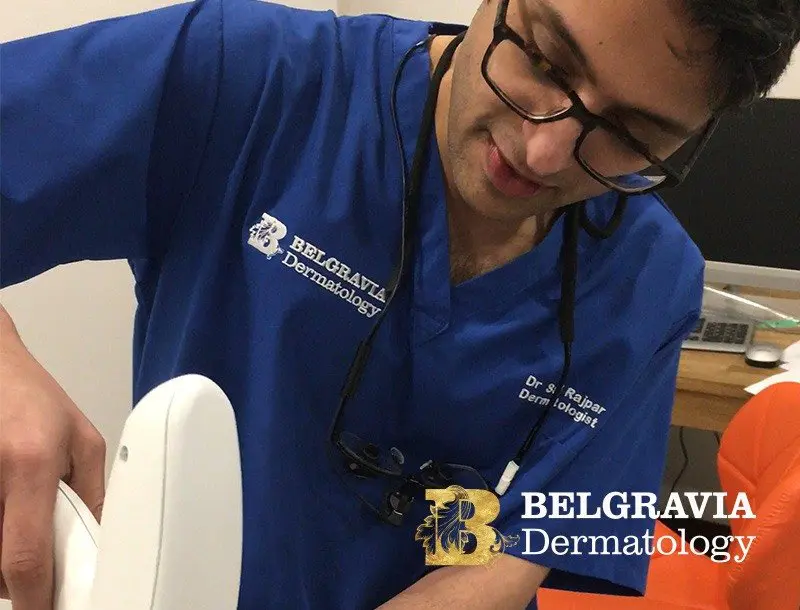
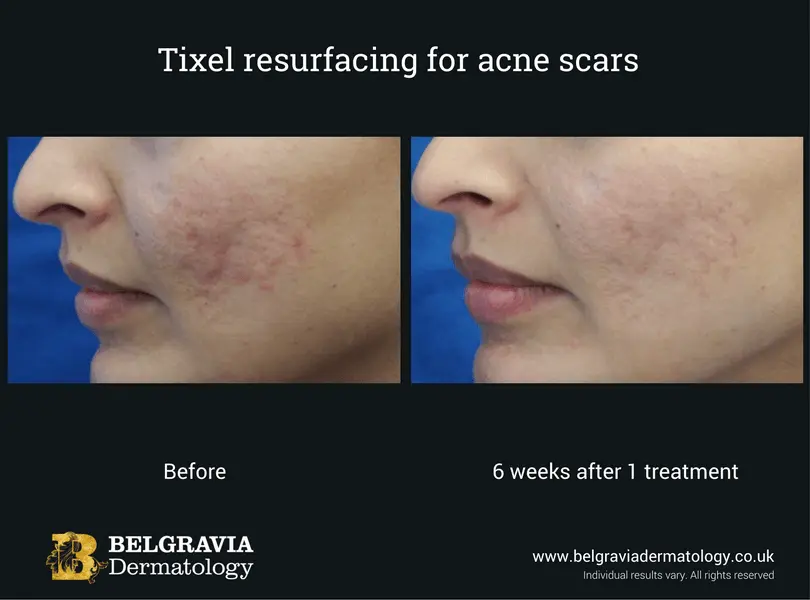

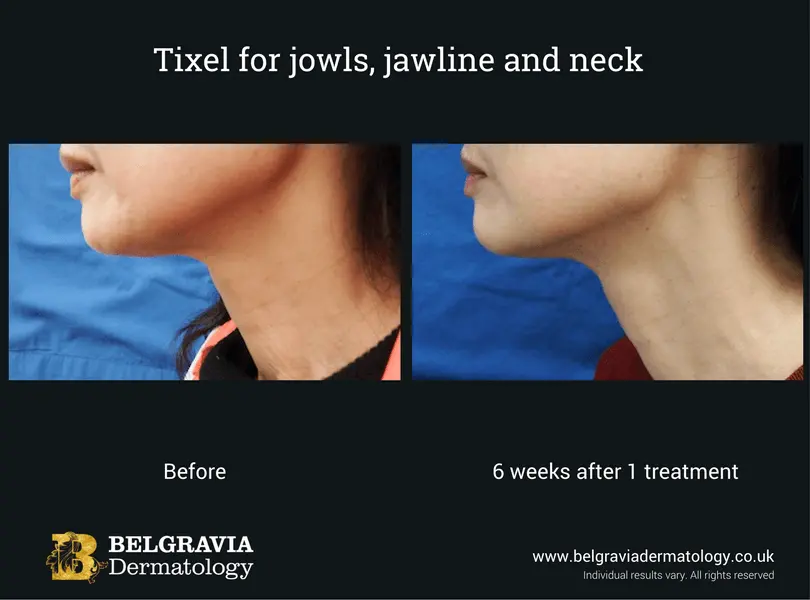
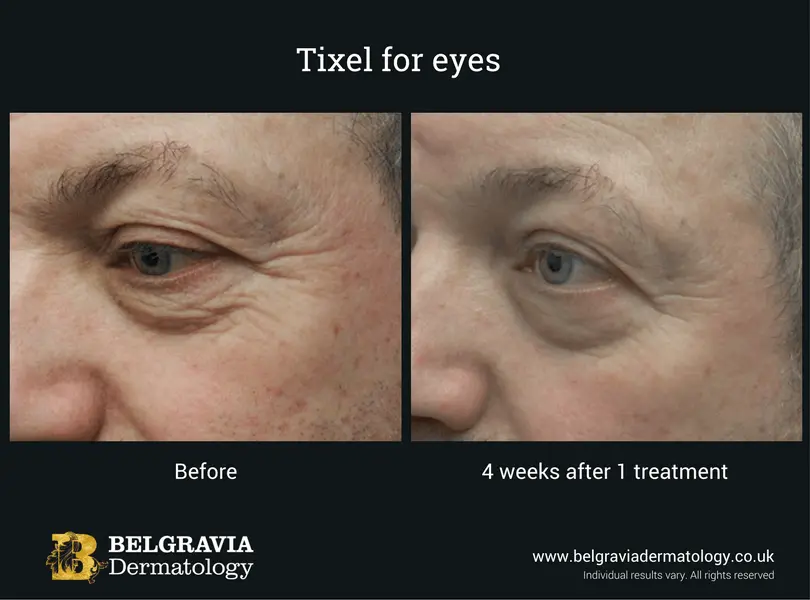



 How Tixel improves the skin:
How Tixel improves the skin: Can men be treated with Tixel?
Can men be treated with Tixel?